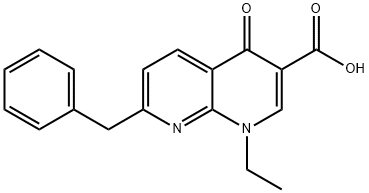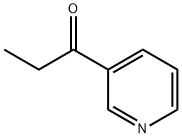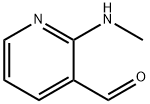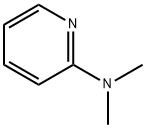Amfonelic Acid , >97.0%(HPLC) , 15180-02-6
Synonym(s):
7-Benzyl-1-ethyl-1,4-dihydro-4-oxo-1,8-naphthyridine-3-carboxylic acid
| Pack Size | Price | Stock | Quantity |
| 10mg | RMB2392.00 | In Stock |
|
| others | Enquire |
PRODUCT Properties
| Melting point: | >1000 °C |
| Boiling point: | 499℃ |
| Density | 1.297 |
| Flash point: | 256℃ |
| solubility | 0.1 M NaOH: soluble |
| form | powder |
| pka | 3.50±0.20(Predicted) |
| color | yellow |
| InChI | InChI=1S/C18H16N2O3/c1-2-20-11-15(18(22)23)16(21)14-9-8-13(19-17(14)20)10-12-6-4-3-5-7-12/h3-9,11H,2,10H2,1H3,(H,22,23) |
| InChIKey | WHHHJDGNBVQNAU-UHFFFAOYSA-N |
| SMILES | N1(CC)C2C(=CC=C(CC3=CC=CC=C3)N=2)C(=O)C(C(O)=O)=C1 |
Description and Uses
Amfonelic acid, a derivative of nalidixic acid, was originally developed as a central nervous system stimulant. It is a highly potent nonamphetamine stimulant whose actions are inhibited by reserpine but not by the tyrosine hydroxylase inhibitor, a-methyltyrosine. Additionally, it enhances the impacts of antipsychotic medicines such as haloperidol, trifluoperazine, and spiperone.
Amfonelic acid (AFA) is a dopamine reuptake inhibitor, that has marked effects on brain dopamine metabolism but not noradrenaline metabolism. Experiments on rats have shown that AFA treatment completely prevented the effects of methamphetamine on the dopaminergic system, both morphologically and biochemically. Rats are shown to self-administer amfonelic acid in a dose-dependent manner.
Safety
| Symbol(GHS) |  GHS07 |
| Signal word | Warning |
| Hazard statements | H302-H315-H319-H335 |
| Precautionary statements | P261-P305+P351+P338 |
| Hazard Codes | Xn |
| Risk Statements | 40-43 |
| Safety Statements | 36/37 |
| WGK Germany | 3 |
| HS Code | 2933.99.8290 |






